- Tournaments
Home › Players › Pelé
B orn on October, 23, 1940 in Minas Gerais, Brazil, Edson Arantes do Nascimento would become more commonly known around the world as Pelé. His father, João Ramos do Nascimento, played professional soccer himself, but his career never brought him much in the way of money. As the legend goes, Pelé’s family could not even afford to buy a ball for him, so he stuffed socks and molded them into the shape of a ball to kick around.

Basic facts
Birth: 1940 Death: 2022 Country: Brazil Position: Forward
Santos FC (1956-1974) New York Cosmos (1975-1977)
Club football: 694 matches, 650 goals National team: 92 matches, 77 goals
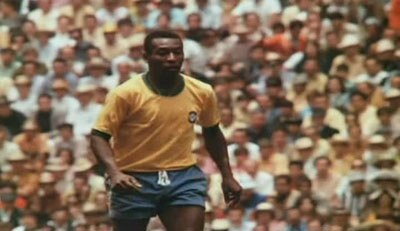
Early career
Although he continued to struggle financially in São Paulo, working a variety of jobs to help his family, the young Pelé found his true talent on the field. Under the tutelage of his father and a former national team player named Waldemar de Brito, Pelé began to mature as a player on the Bauru Athletic Club juniors. Coach de Brito recognized his ability and recommended him for a tryout with Santos FC. The team’s management agreed with de Brito’s assessment and signed Pelé in June 1956. A mere three months later, Pelé scored a goal in his debut match. Although few people knew it at the time, this foreshadowed the success to come in the rest of Pelé’s professional career.
Stardom of a youngster
Only a short year later, Pelé topped the list of scorers in the league. His performance, at the tender age of 17, caught the attention of the national team. He would not disappoint. In his first appearance on the world stage, he scored key goals in both the semifinal and the final match of the 1958 World Cup to win it for Brazil . At this point, he had achieved superhero status in Brazil and became a household name around the world. The Brazilian government honored him as a “national treasure,” which elevated his status at home, but also prevented him from taking advantage of offers a broad.
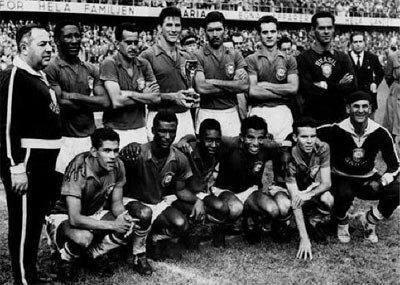
Struggle with injuries
On an individual level, the next two World Cups turned out disappointing due to injuries. The Brazilian side still won the tournament in 1962, but they fell way short in 1966 without their star player—they were eliminated in the group stage. During this era, though, Pelé continued to excel on his club team, Santos. Consistently a top scorer, he often faced teams who had altered their play specifically to deal with the threat he posed. Despite this, he still managed to score 60 goals in the 1964 season and 101 goals the year after that.
Retirement and comeback
By the time 1970 rolled around, Pelé had reportedly decided to hang up his hat and leave while he was on top. However, he was eventually coaxed into playing one last World Cup for Brazil in Mexico on what many consider as the best team in history. Pelé contributed to Brazil’s tournament win with goals and several important assists, earning himself the Golden Ball award for his play. Pelé continued with the Brazilian team for about another year, finally calling it quits in 1971. A few years after that, he said goodbye to his fans at Santos, too. His days as a player were still not over, though.
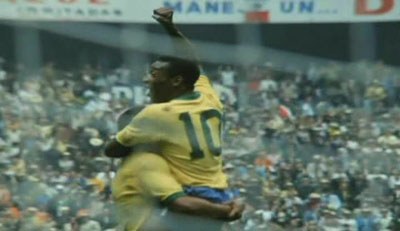

Late career
Although he had long said that he would only ever play for Santos, he could not resist answering the call from the New York Cosmos in 1975. The North American Soccer League (NASL) represented a significant step down in terms of the level of play that Pelé was accustomed to. The burgeoning league benefitted greatly from this ambassador of the game, though, and ticket sales rose. The American public, largely unfamiliar with the game, took notice. Pelé led the Cosmos to a championship before retiring for good, an event marked by an exhibition match between his adoptive New York team and Santos.
Legacy and life after the football career
At the time of his retirement in 1977, Pelé had amassed a series of seemingly unbreakable records. He had racked up a total of 1,283 goals in 1,363 matches, making him the top scorer in Brazilian national team history and FIFA history. Just as impressively, he managed to pull off 92 hat-tricks. He also set a record for the most FIFA World Cup wins for an individual, with three medals to his name. His early years should not be overlooked, though. The young Pelé burned bright, becoming the youngest player to score a hat-trick and the youngest player to score in a World Cup final match. Retirement saw “O Rei” go on to campaign for a variety of causes, including poverty reduction, anti-corruption movements, and environmental protection. He also received an honorary knighthood, served as the Minister of Sport in Brazil, and assumed the role of a UNICEF Goodwill ambassador. Of course, he never stopped promoting the game throughout the world, including FIFA events and Olympic ceremonies. Perhaps most memorable of all, he popularized the phrase “the beautiful game” as shorthand for the game he loved so much. Generations of enthusiasts have imagined themselves playing with the grace and beauty of “The Black Pearl.” He could strike the ball with astonishing accuracy or flick it off to a teammate through a thick web of defenders’ legs. His iconic goal-scoring bicycle kick in Belgium in 1968 sent young players from all over rushing outside for hours of painful practice. What dazzled many of his fellow players was his uncanny ability to work his way out of almost any situation with sheer skill. For those who have wondered about the origin of the name “Pelé,” the answer proves elusive. Some have claimed that it came from Pelé’s poor pronunciation of the name of a goalie he admired named “Bilé.” According to this version of events, his teammates half-mockingly gave him the name “Pelé” and he could not shake it. Pelé himself has never given a definitive account of how he got the name. In fact, he claimed he never cared for it much. Like so much else in this superstar’s life, though, the magic lies not in minute biographical details or trivia, but in the legacy that Pelé left on the field. Pelé passed away in december 2022, at the age of 82.
By Rosa Nelson
More articles
› Rivellino – King of the Park › Lev Yashin – The Black Spider › Alfredo Di Stéfano – The Blond Arrow
References: http://www.biography.com/people/pel%C3%A9-39221#more-world-cup-titles http://www.telegraph.co.uk/sport/football/world-cup/10874465/How-and-why-Peles-mystique-and-reputation-as-the-worlds-greatest-ever-footballer-has-been-overhyped.html http://www.goal.com/en/news/60/south-america/2010/10/21/2176031/70-facts-about-brazil-legend-pele Image source: Image sources: 1, 3 FIFA – World Cup Official Film 1970 2 Scanpix
Football Players
- Marco van Basten
- Franz Beckenbauer
- David Beckham
- Dennis Bergkamp
- George Best
- Zbigniew Boniek
- Bobby Charlton
- Johan Cruyff
- Alfredo Di Stéfano
- Steven Gerrard
- Gheorghe Hagi
- Ruud Gullit
- Thierry Henry
- Michael Laudrup
- Diego Maradona
- Gerd Müller
- Michel Platini
- Juan Román Riquelme
- Arjen Robben
- Hugo Sánchez
- Hristo Stoichkov
- Hakan Şükür
- George Weah
- Zinedine Zidane
- Gianfranco Zola
Skills, charisma, mysticism: The life of football legend Pele
The world bids farewell to one of the greatest footballers ever seen.
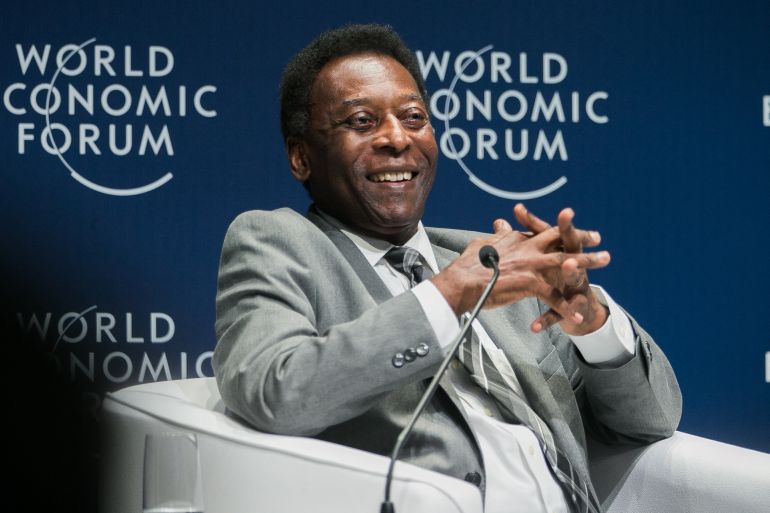
Santos, Brazil – A famous sports writer once said that “if Pelé had not been born a man, he would have been born a football”.
Pelé – real name Edson Arantes do Nascimento – one of the greatest footballers the world had ever seen, died on Thursday at the age of 82.
Born in the state of Minas Gerais in 1940, Pelé’s family moved to a nearby city called Bauru looking for a better life. He grew up in poverty and his parents could not even afford a football. An old sock filled with newspapers was the first “ball” his magical feet kicked but it was enough for him to fall in love with the game and for people to start noticing he was different.
When Pelé was 15, a local coach, Waldemar de Brito, took him to play for the football club Santos. Upon arriving in the city that shares the name with the club, Brito told the coach, “This kid will be the best in the world.”
Within minutes, the coach was impressed with Pelé and signed him on the spot. This was 1956. Two years later, Pelé would be in Sweden, spearheading Brazil to a World Cup title, the first of six for the team. He scored two goals in the final against Sweden. He was still 17.
At the final whistle, the wonder kid fainted on the field while being carried by the celebrating crowd.
Pelé was famously easy-going, kind, joyful, and a reliable friend.
“Pelé was always a very nice guy. We would spend so much time talking. He didn’t have any star attitude,” Didi, 84, one of Pelé’s oldest friends and his barber of 55 years, told Al Jazeera.
“I tell my grandchildren that I had one client more famous than anyone else. This is a man who is known more all over the world than Coca Cola. So I feel proud of it and it’s very rare for someone to have a client like this.”
Pelé had a certain way of speaking Portuguese, something he would turn into a trademark. He would constantly finish his sentences with “entende?” which means “understand?”.
It seems he always wanted to make sure to facilitate conversations, just like he would smooth out his teammates’ game.
In addition to skills and charisma, a certain mysticism always surrounded the character of the King of Football. Pelé was from a city called Três Corações, which translates to Three Hearts.
One of his many famous quotes, made at his last match ever played in 1977 in New York, was honouring children and with his limited English, he just said “love, love, love.”
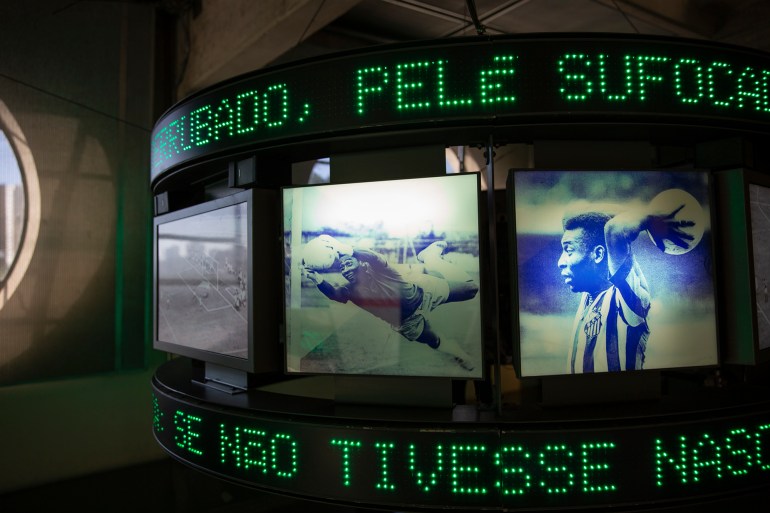
On the pitch, Pelé became an instant celebrity following the 1958 World Cup triumph. Upon returning to Brazil, he helped Santos build a dynasty, winning 25 titles in the 1960s. Despite being world-famous, Pelé kept living a down-to-earth life in Santos. He would share a guest house with other players and cycle around the city.
“The pay was pretty bad but he did it for love of the game and we had so much fun,” Carlos “Lala”, 86, a goalkeeper and Pelé’s former Santos teammate, told Al Jazeera.
Despite being a widely diverse country ethnically, Brazil is not often represented by people of colour. So having someone Black as its biggest celebrity and star had a cultural impact on the country.
Aside from being the world’s best footballer, Pelé also ventured into showbusiness. A lover of music, he recorded an album with Brazilian legendary singer Elis Regina and acted in a handful of movies, making him a pop star as well.
In 1962, Brazil won a second successive World Cup with an injured Pelé supporting the team.
It was in 1970, at the first World Cup broadcasted in colour, that Pelé put the cherry on top of his football legacy. The team that had Clodoaldo, Rivelino and Tostão, put in one of the most celebrated World Cup performances in history.
In the final, a 4-1 win over Italy, Pelé scored a header – the team’s opening goal – that some people said he managed by freezing midair. He celebrated the goal in his typical manner: Jumping and punching the air.
“I told myself before the game that Pelé is made of skin and bones just like everyone else. But I was wrong,” said Tarciso Burnigch, the Italian defender appointed to mark Pelé in the final.
That was Pelé’s 12th and final World Cup goal.
In 1969, he had become the first player to score 1,000 goals. The 1,000th goal was at the Maracanã, in Rio de Janeiro, known as the Mecca of Football.
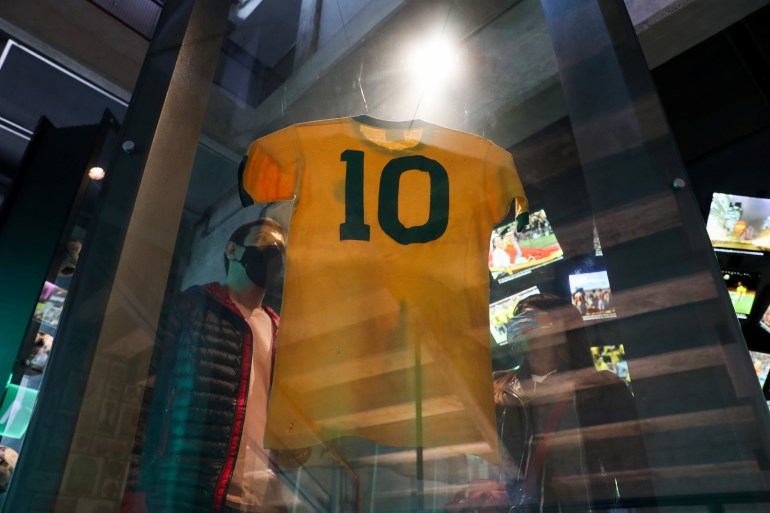
In 1974, he left Santos and played his final years in New York, at a club called Cosmos.
It was the only team he played for other than Santos and Brazil’s national side.
“As we [the security team] were always with the team, traveling, at the games, we had a lot of contact with them, so we developed a friendship,” Pedro de Liberato, Pele’s security guard, and then his neighbour, told Al Jazeera.
“Pelé was always very joyful, always joking with people,” the 90-year-old added.
Pelé wore the number 10 jersey but he did not know which number he would have and was assigned 10 randomly.
The number 10 jersey has since then become associated with the world’s best – Maradona, Roberto Baggio, Zinedine Zidane and Lionel Messi are just some of them who have worn it.
Pelé retired after playing 1,363 games, winning 37 titles, scoring 1,281 goals, including 92 career hat-tricks.
He spent his post-football life involved in social activism, including being a UNESCO goodwill ambassador.
In 1995, he took public office as minister of sports, introducing the legislation that grants players their own rights after a certain age. Pelé also commented on games for television.
In recent years, Pelé struggled with his health. Aside from battling cancer, he also suffered from severe hip pain and spent most of his last years in a wheelchair.

IMAGES
VIDEO
COMMENTS
Edson Arantes do Nascimento , better known by his nickname Pelé (Portuguese pronunciation: [peˈlɛ]), was a Brazilian professional footballer who played as a forward. Widely regarded as one of the greatest players in the history of the sport, he was among the most successful and popular sports figures of the 20th century. His 1,279 goals in 1,363 games, which includes friendlies, is recognise…
Soccer legend Pelé became a superstar with his performance in the 1958 World Cup. Pelé played professionally in Brazil for two decades, winning three World Cups along the way, before joining the...
Without any doubt, he is universally regarded as the greatest player of the twentieth century – if not all time. He is one of the few sportsman like Muhammad Ali and Usain Bolt, who transcend …
Pele was a legendary sporting figure and an iconic soccer player who during his active years ruled the game to the point of being called the ‘King of Football’. He is widely regarded by football fans, critics, experts, and players (current and …
Birth: 1940. Death: 2022. Country: Brazil. Position: Forward. Clubs. Santos FC (1956-1974) New York Cosmos (1975-1977) Stats. Club football: 694 matches, 650 goals. National team: 92 matches, 77 goals. Pelé 1970 in World Cup for …
Pelé – real name Edson Arantes do Nascimento – one of the greatest footballers the world had ever seen, died on Thursday at the age of 82. Born in the state of Minas Gerais in 1940, Pelé’s family...